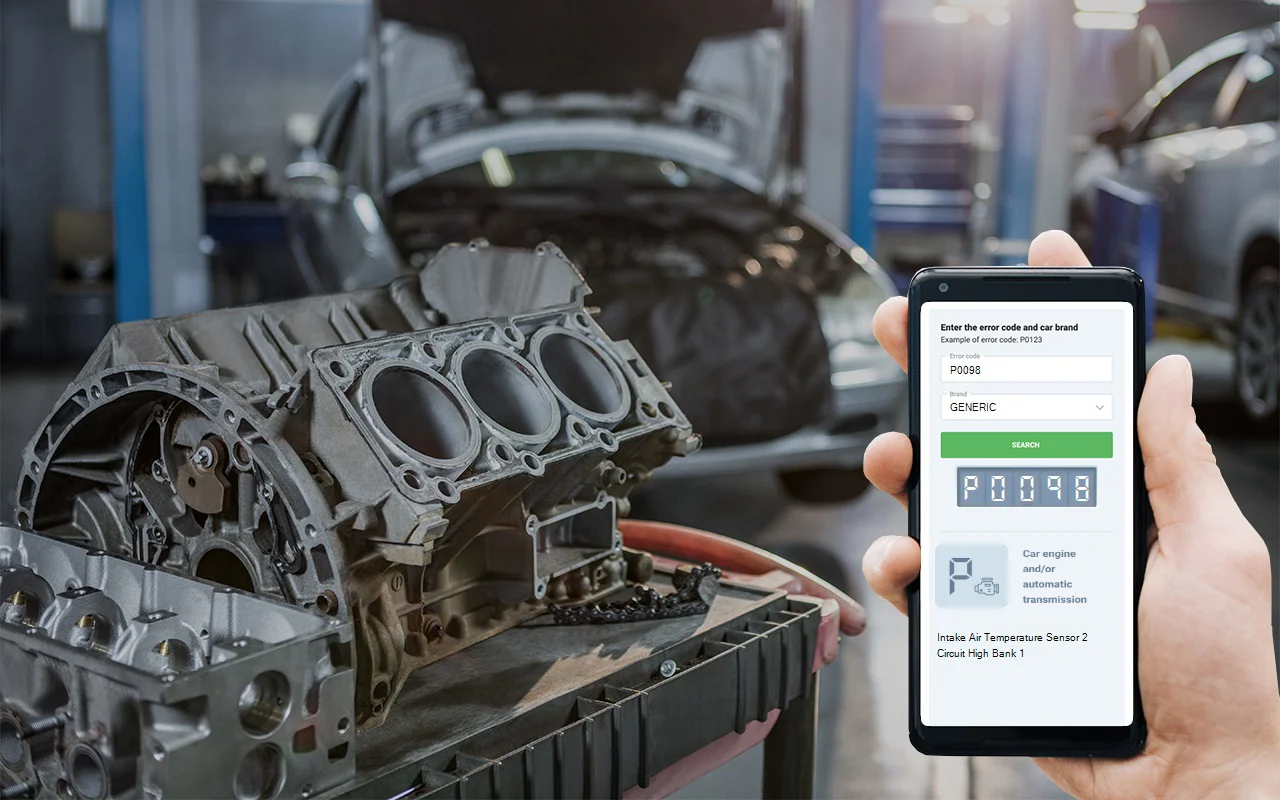Let me break down what P0098 means for you: this code stands for “Intake Air Temperature (IAT) Sensor 2 Circuit High (Bank 1).” In plain English, your car’s computer (the PCM) is seeing a signal from the second intake air temperature sensor that’s higher than it should be. The IAT sensor’s job is to measure the temperature of the air coming into your engine, which helps the computer adjust fuel and timing for the best performance and efficiency. When the signal is out of range, the computer can’t trust the reading, so it sets this code and usually turns on your check engine light. This sensor is part of the engine’s air intake system, and its readings are crucial for smooth running, especially in changing weather or driving conditions.
DTC P0098
Causes of P0098 code
From what I see most often in the shop, the P0098 code is usually caused by one of three things:
- A faulty IAT sensor #2 itself - these sensors can wear out or fail over time.
- Problems with the wiring or connectors - like broken wires, corrosion, or loose plugs that mess with the signal.
- In rare cases, a problem inside the PCM (the car’s computer) can be the culprit, but that’s much less common.
In my experience, wiring issues and sensor failures are by far the most frequent reasons for this code popping up. This error can also happen on car brands like Volkswagen, Ford, and Renault.
Symptoms of dtc P0098
When this code is active, here’s what you’re likely to notice:
- The check engine light will come on - that’s usually the first sign.
- You might feel the engine isn’t running as smoothly as usual, with a bit less power or sluggish acceleration.
- Fuel economy can take a hit, so you may find yourself filling up more often.
Honestly, a lot of folks don’t notice much difference in how the car drives, but that doesn’t mean it’s safe to ignore.

Diagnosis of P0098 engine code
Here’s how I’d tackle diagnosing a P0098, step by step:
- First, I always start by checking the basics - pop the hood and inspect the wiring and connector at the IAT sensor #2. Look for any obvious damage, corrosion, or loose connections. Sometimes just plugging the connector back in properly solves the problem.
- If everything looks good visually, I’ll use a scan tool to clear the code and see if it comes back. If it does, I move on to testing the sensor itself. With a multimeter, I check the sensor’s resistance and compare it to the specs in the service manual. If it’s way off, the sensor’s probably bad.
- If the sensor checks out, I’ll test the wiring between the sensor and the PCM for any breaks or shorts. This can take a bit of patience, so it’s helpful to have someone wiggle the wires while you watch the readings.
- Only after ruling out the sensor and wiring do I consider the PCM as a possible cause - but honestly, that’s pretty rare.
It’s best to have someone assist you, especially when checking wiring continuity or wiggling connectors. Don’t forget to double-check the sensor’s connector for bent pins or moisture before moving on. The p0098 code is typically found during this process.

Common Mistakes with P0098
One thing I see a lot is folks replacing the IAT sensor right away without checking the wiring or connector first. That’s a surefire way to waste money if the real problem is just a loose plug or corroded pin. Another common slip-up is not using the correct specs from the service manual when testing the sensor - every car is a little different. Skipping the basics and jumping straight to expensive parts is a mistake I’d hate to see you make. For those working on a dtc p0098 Volkswagen, always verify the wiring before replacing components.

Seriousness of P0098 trouble code
While P0098 might not leave you stranded, it’s not something to shrug off. If you ignore it, you risk running your engine with the wrong air-fuel mixture, which can lead to poor performance, higher fuel bills, and over time, even damage to things like your catalytic converter. You don’t want this kind of trouble on the road - things can go south quickly if overlooked, especially if the engine starts running too rich or too lean. It’s always better to fix it before it snowballs into a bigger, more expensive problem. Keep in mind, even obd p0098 can indicate a deeper engine management issue if left unresolved.
Repair solutions for obd2 code P0098
Here’s what usually fixes a P0098, based on what I see in the field:
- Repair or replace any damaged wiring or connectors at the IAT sensor #2.
- If the sensor itself is faulty, swap it out for a new one - just make sure it’s the correct part for your vehicle.
- In rare cases, if the PCM is at fault, it may need to be reprogrammed or replaced, but that’s really a last resort.
After repairs, always clear the code and take the car for a test drive to make sure it doesn’t come back. That’s the best way to confirm you’ve nailed the fix.
Conclusion
To sum it up, P0098 means your car’s computer isn’t getting a proper reading from the intake air temperature sensor #2, usually because of a bad sensor or wiring issue. It’s not the most urgent code out there, but don’t put this off for later - it can lead to bigger headaches if ignored. Start with a careful inspection of the sensor and wiring, and only move on to more complex fixes if needed. From experience, most of these cases are solved with a simple repair or sensor replacement. That’s the most reliable way to get your engine running right again and keep you out of trouble down the road.




